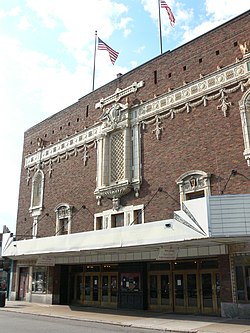Byrd Theatre
|
Byrd Theatre
|
|
 |
|
| Location | 2908 W. Cary St., Richmond, Virginia |
|---|---|
| Coordinates | 37°33′9″N 77°28′41″W / 37.55250°N 77.47806°WCoordinates: 37°33′9″N 77°28′41″W / 37.55250°N 77.47806°W |
| Area | less than one acre |
| Built | 1928 |
| Architect | Fred Bishop |
| Architectural style | Italian Renaissance |
| NRHP Reference # | 79003289 |
| VLR # | 127-0287 |
| Significant dates | |
| Added to NRHP | September 24, 1979 |
| Designated VLR | June 21, 1977 |
The Byrd Theatre is a cinema in the Carytown neighborhood of Richmond, Virginia. It was named after William Byrd II, the founder of the city. The theater opened on December 24, 1928 to much excitement and is affectionately referred to as "Richmond’s Movie Palace". It was the first cinema in Virginia to be outfitted when built with a sound system (although other existing theaters had already been retrofitted for sound).
Built in 1928, the theater cost $900,000 (inflation adjusted equivalent $12,430,000 in 2014) to construct. The builders were Charles Somma and Walter Coulter. The original name for the theater was the State Theater, but by the completion of the construction the name was already taken. It was then named after William Byrd II, founder of the city of Richmond.
The Byrd Theatre opened for the first time on December 24, 1928. At the time, adult tickets were 50 cents for evening shows and 25 cents for matinees, while a child’s tickets was only 10 cents. The first movie was the film "Waterfront", a First National Film starring Dorothy Mackaill and Jack Mulhall. In addition, the manager at the time was Robert Coulter, who remained the manager until his retirement in 1971 (he is rumored to haunt the theatre).
In 1953, the original 35mm Simplex standards were replaced by Simplex 35mm projectors and the theater now uses digital projectors as seen on a Historic Richmond 2015 tour of the projection room.
The pre-1953 arc lamp is still used to project the Byrd Theater logo on the curtain.
The theatre’s architect and contractor was Fred Bishop, and is considered to be of a Renaissance Revival design. Inside, the theatre contains orchestra seating (main) for 916 and balcony seating for 476. The balcony is open whenever attendance requires and occasionally at other times by making a donation to the Byrd Theatre Foundation. The interior features a lavish design by the Arthur Brunet Studios of New York. In addition to eleven Czechoslovakian Crystal Chandeliers, including an 18-foot, two-and-a-half ton chandelier suspended over the auditorium (with over 5,000 crystals illuminated by 500 red, blue, green and amber lights), the interior features imported Italian and Turkish marble, hand-sewn velvet drapes, and oil on canvas murals of Greek mythology. More unusual features included a central vacuum system and a natural spring which used to supply water to the air conditioning system.
...
Wikipedia


